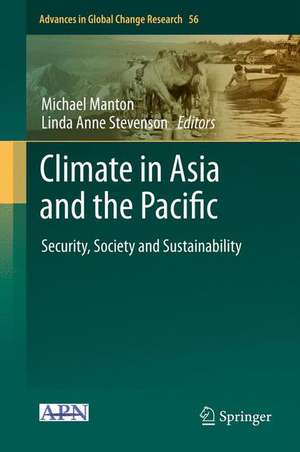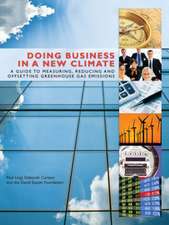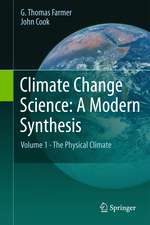Climate in Asia and the Pacific: Security, Society and Sustainability: Advances in Global Change Research, cartea 56
Editat de Michael Manton, Linda Anne Stevensonen Limba Engleză Hardback – 24 oct 2013
| Toate formatele și edițiile | Preț | Express |
|---|---|---|
| Paperback (1) | 698.80 lei 6-8 săpt. | |
| SPRINGER NETHERLANDS – 23 aug 2016 | 698.80 lei 6-8 săpt. | |
| Hardback (1) | 653.14 lei 6-8 săpt. | |
| SPRINGER NETHERLANDS – 24 oct 2013 | 653.14 lei 6-8 săpt. |
Din seria Advances in Global Change Research
- 15%
 Preț: 636.12 lei
Preț: 636.12 lei -
 Preț: 439.83 lei
Preț: 439.83 lei - 18%
 Preț: 895.45 lei
Preț: 895.45 lei - 15%
 Preț: 648.24 lei
Preț: 648.24 lei - 18%
 Preț: 1036.54 lei
Preț: 1036.54 lei - 18%
 Preț: 894.16 lei
Preț: 894.16 lei - 18%
 Preț: 963.60 lei
Preț: 963.60 lei - 18%
 Preț: 1239.49 lei
Preț: 1239.49 lei - 15%
 Preț: 649.71 lei
Preț: 649.71 lei - 18%
 Preț: 1243.78 lei
Preț: 1243.78 lei - 18%
 Preț: 1114.02 lei
Preț: 1114.02 lei - 15%
 Preț: 648.89 lei
Preț: 648.89 lei - 18%
 Preț: 960.78 lei
Preț: 960.78 lei - 15%
 Preț: 643.99 lei
Preț: 643.99 lei - 18%
 Preț: 1834.44 lei
Preț: 1834.44 lei - 15%
 Preț: 649.06 lei
Preț: 649.06 lei - 18%
 Preț: 955.70 lei
Preț: 955.70 lei - 18%
 Preț: 956.03 lei
Preț: 956.03 lei - 18%
 Preț: 1232.26 lei
Preț: 1232.26 lei - 18%
 Preț: 955.88 lei
Preț: 955.88 lei - 18%
 Preț: 959.19 lei
Preț: 959.19 lei - 18%
 Preț: 944.82 lei
Preț: 944.82 lei - 18%
 Preț: 1105.19 lei
Preț: 1105.19 lei - 15%
 Preț: 644.49 lei
Preț: 644.49 lei - 15%
 Preț: 643.99 lei
Preț: 643.99 lei - 18%
 Preț: 1841.54 lei
Preț: 1841.54 lei - 18%
 Preț: 1225.94 lei
Preț: 1225.94 lei - 18%
 Preț: 954.62 lei
Preț: 954.62 lei - 5%
 Preț: 1414.80 lei
Preț: 1414.80 lei
Preț: 653.14 lei
Preț vechi: 768.40 lei
-15% Nou
Puncte Express: 980
Preț estimativ în valută:
124.98€ • 130.84$ • 103.41£
124.98€ • 130.84$ • 103.41£
Carte tipărită la comandă
Livrare economică 05-19 aprilie
Preluare comenzi: 021 569.72.76
Specificații
ISBN-13: 9789400773370
ISBN-10: 9400773374
Pagini: 200
Ilustrații: XVIII, 317 p. 45 illus., 41 illus. in color.
Dimensiuni: 155 x 235 x 20 mm
Greutate: 0.77 kg
Ediția:2014
Editura: SPRINGER NETHERLANDS
Colecția Springer
Seria Advances in Global Change Research
Locul publicării:Dordrecht, Netherlands
ISBN-10: 9400773374
Pagini: 200
Ilustrații: XVIII, 317 p. 45 illus., 41 illus. in color.
Dimensiuni: 155 x 235 x 20 mm
Greutate: 0.77 kg
Ediția:2014
Editura: SPRINGER NETHERLANDS
Colecția Springer
Seria Advances in Global Change Research
Locul publicării:Dordrecht, Netherlands
Public țintă
GraduateCuprins
Foreword by Helen Clarke.- Foreword by Ghassem Asrar.- Foreword by Scott Hauger.- Preface.- 1. Introduction.- 2. Climate Variability and Change.- 3. Climate and Urbanization.- 4. Climate and Security.- 5. Climate and Society.- 6. Climate and Sustainability.- 7. Future Directions for Climate Research in Asia and the Pacific.- Index.
Textul de pe ultima copertă
Commissioned by the Intergovernmental Meeting (IGM) of the Asia-Pacific Network for Global Change Research (APN), this book offers a detailed survey of the current status of climate change and climate variability in the Asia-Pacific region, a thorough and thoughtful assessment of climate and security and clear recommendations on the best paths of climate research in the future.
The opening chapter addresses current understanding of the interactions between climate, natural ecosystems and human communities across Asia and the Pacific. Chapter 2 outlines variability and change in the region, from the El Niño-Southern Oscillation (ENSO) to glaciers, tropical cyclones and extreme weather events, as well as the latest methods of measuring and collecting data and advanced techniques for creating climate models and projections. The contributors go on to unfold the many layers of this complex scientific puzzle and its political context.
Chapter 3 describes urban trends and risks and hazards from consequences of climate change, including rising temperatures and rising sea levels and highlights their effects on transportation, water supply, agriculture, food supply and energy production. Methods for adaptation and mitigation are outlined, and the contributors point out uncertainties, gaps in research and policy needs. Chapter 4 takes a broad perspective on the current and future state of agriculture and fisheries, on issues of water security from the Himalayan-Tibetan plateau to the islands of the Pacific and on energy demands and production capacity with close-up analyses of China, India and Japan. Chapter 5 examines climate and society at many levels, with special attention to remote communities in mountainous and small island settings. Chapter 6 exploressustainability, reporting on efforts to initiate and advance low carbon development, and strategies for adaptation and mitigation in natural ecosystems. The last chapter summarizes the findings presented in the book and offers a picture of future needs for climate research in the region.
As J. Scott Hauger, of the Asia Pacific Center for Security Studies writes in his foreword, this book “represents an opportunity to share knowledge and to collaborate across . . . groups and perspectives to manage the complex problems of climate related global change, to ensure a secure and sustainable environment for our children and posterity.”
The opening chapter addresses current understanding of the interactions between climate, natural ecosystems and human communities across Asia and the Pacific. Chapter 2 outlines variability and change in the region, from the El Niño-Southern Oscillation (ENSO) to glaciers, tropical cyclones and extreme weather events, as well as the latest methods of measuring and collecting data and advanced techniques for creating climate models and projections. The contributors go on to unfold the many layers of this complex scientific puzzle and its political context.
Chapter 3 describes urban trends and risks and hazards from consequences of climate change, including rising temperatures and rising sea levels and highlights their effects on transportation, water supply, agriculture, food supply and energy production. Methods for adaptation and mitigation are outlined, and the contributors point out uncertainties, gaps in research and policy needs. Chapter 4 takes a broad perspective on the current and future state of agriculture and fisheries, on issues of water security from the Himalayan-Tibetan plateau to the islands of the Pacific and on energy demands and production capacity with close-up analyses of China, India and Japan. Chapter 5 examines climate and society at many levels, with special attention to remote communities in mountainous and small island settings. Chapter 6 exploressustainability, reporting on efforts to initiate and advance low carbon development, and strategies for adaptation and mitigation in natural ecosystems. The last chapter summarizes the findings presented in the book and offers a picture of future needs for climate research in the region.
As J. Scott Hauger, of the Asia Pacific Center for Security Studies writes in his foreword, this book “represents an opportunity to share knowledge and to collaborate across . . . groups and perspectives to manage the complex problems of climate related global change, to ensure a secure and sustainable environment for our children and posterity.”
Caracteristici
Offers a broad perspective on the impacts of climate change on society in Asia and the Pacific Explores a many-layered mix of science, economics, politics and sociological concerns Provides a useful resource for scientists, policy makers and practitioners Includes supplementary material: sn.pub/extras








